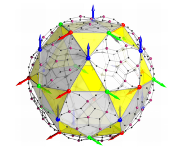Speaker
Description
The chiral magnet MnSi possesses a non-centrosymmetric chemical unit cell. The non-centrosymmetry has profound consequences for spin-wave dynamics in all ordered magnetic phases of MnSi. Namely, it introduces a Dzyaloshinskii-Moriya term, which causes magnons to be created at different absolute energies than they are annihilated. This asymmetry ("non-reciprocity") in the dispersion is limited to reduced momentum transfer components parallel to the applied magnetic field direction, i.e. the skyrmion axis.
Using the new triple-axis spectrometer ThALES at the ILL, we performed a longitudinal polarization analysis of the skyrmion dynamics in MnSi for direction in reciprocal space both along and perpendicular to the skyrmion axis. Individual polarization-dependent dispersion branches could be clearly resolved in the first direction, while for the second direction we found a broad quasi-continuum of dispersion branches. Utilizing the Monte-Carlo convolution of a linear spin-wave model [1] and the instrumental resolution function, we achieved an excellent quantitative agreement between experiment and theory.
[1] M. Garst, et al., Journal of Physics D 50(29), 293002 (2017).
This work will be part of a comprehensive paper on skyrmion dynamics:
T. Weber, D. Fobes, J. Waizner, L. Beddrich, P. Steffens, G. Tucker, R. Bewley, M. Skoulatos, R. Georgii, P. Link, G. Ehlers, A. Bauer, C. Pfleiderer, P. Böni, M. Janoschek, and M. Garst, in preparation.

